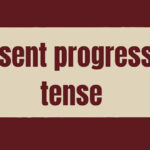The present progressive tense, also known as the present continuous tense, is used to describe an ongoing action that is happening at the present moment or around the current time.
It is formed by using the auxiliary verb “to be” in the present tense, followed by the present participle (-ing form) of the main verb.
Here are some examples of sentences in the present progressive tense:
1. I am studying for my exams.
2. She is writing a letter to her friend.
3. They are playing basketball in the park.
4. We are watching a movie at the theater.
5. He is cooking dinner in the kitchen.
6. The children are sleeping in their beds.
7. It is raining outside.
8. The dog is chasing its tail.
9. The teacher is explaining a new lesson to the students.
10. Sarah is working on a project for her job.
In all these examples, the action is happening in the present or around the current time, and the verbs are in the “-ing” form (present participle) to indicate the ongoing nature of the action.
Formula or Structure:
The formula or structure of the present progressive tense is as follows:
Subject + Auxiliary verb “to be” (in the present tense) + Main verb (present participle form, ending in -ing) + Optional: Rest of the sentence
Here is a breakdown of the structure:
– Subject:
This refers to the person or thing performing the action.
– Auxiliary verb “to be”:
The appropriate form of the verb “to be” is used based on the subject (am, is, are).
– Main verb:
The main verb is used in its present participle form, which adds -ing to the base verb.
– Optional:
The rest of the sentence can include additional information or objects related to the action.
Let’s see some examples using this structure:
1. I am studying for my exams.
2. She is writing a letter to her friend.
3. They are playing basketball in the park.
4. We are watching a movie at the theater.
In these examples, “am,” “is,” and “are” are the auxiliary verbs “to be” conjugated in the present tense according to the subject.
The main verbs (studying, writing, playing, watching) are in the present participle form, ending in -ing.
Here’s the breakdown of the structure for positive, negative, and interrogative sentences in the present progressive tense:
Positive sentence structure:
Subject + Auxiliary verb “to be” (in the present tense) + Main verb (present participle form, ending in -ing) +
Optional: Rest of the sentence
Negative sentence structure:
Subject + Auxiliary verb “to be” (in the present tense) + “not” + Main verb (present participle form, ending in -ing) + Optional: Rest of the sentence
Interrogative sentence structure:
Auxiliary verb “to be” (in the present tense) + Subject + Main verb (present participle form, ending in -ing) + Optional: Rest of the sentence
Let’s see examples of each:
Positive:
1. Subject: I
Auxiliary verb: am
Main verb: studying
Example:
I am studying for my exams.
2. Subject: She
Auxiliary verb: is
Main verb: writing
Example:
She is writing a letter to her friend.
Negative:
1. Subject: They
Auxiliary verb: are
Negative: not
Main verb: playing
Example:
They are not playing basketball in the park.
2. Subject: We
Auxiliary verb: are
Negative: not
Main verb: watching
Example:
We are not watching a movie at the theater.
Interrogative:
1. Auxiliary verb: Are
Subject: you
Main verb: studying
Example: Are you studying for your exams?
2. Auxiliary verb: Is
Subject: the dog
Main verb: chasing
Example:
Is the dog chasing its tail?
In all these examples, the subject, auxiliary verb “to be” (am, is, are), and main verb (present participle form) are combined to form positive, negative, and interrogative sentences in the present progressive tense.
Rules for forming present progressive tense:
Here are the rules for forming and using the present progressive tense:
1. Formation:
– Use the appropriate form of the auxiliary verb “to be” (am, is, are) based on the subject.
– Add the present participle form (verb + -ing) of the main verb.
2. Subject-Verb Agreement:
– The form of the verb “to be” (am, is, are) should agree with the subject.
– I am, you are, he/she/it is, we are, they are
3. Negation:
– To make a negative sentence, add “not” after the auxiliary verb “to be.”
– Example: She is not writing a letter.
4. Contractions:
– It is common to use contractions in the present progressive tense.
– Examples: I’m (I am), he’s (he is), they’re (they are), etc.
5. Time Frame:
– The present progressive tense is used to describe ongoing actions happening at the present moment or around the current time.
– It emphasizes the temporary nature of the action.
6. Temporary Actions and Future Plans:
– The present progressive tense can also be used to express temporary actions or future plans.
– Examples: I’m staying with my friend this week. We’re going to the concert tomorrow.
7. Non-Continuous Verbs:
– Some verbs are not typically used in the progressive form (state verbs) because they express a state rather than an action.
– Examples: believe, like, love, want, know, understand, etc.
– However, they can be used in the progressive form when expressing a temporary action.
– Example: I’m loving this movie (temporary action), but I love movies in general (state).
Remember that the rules can vary depending on the context or specific verb usage.
It’s important to consider the meaning and intention of the sentence when choosing the appropriate tense.
How to explain present progressive tense to students:
When explaining the present progressive tense to students, it’s helpful to use simple and relatable language. Here’s a step-by-step approach:
1. Start with the basics:
– Introduce the present progressive tense as a way to talk about actions happening right now or around the current time.
– Explain that it’s used to describe ongoing actions that are temporary or in progress.
2. Formulation:
– Break down the structure of the present progressive tense: Subject + Auxiliary verb “to be” (am, is, are) + Main verb (present participle form, ending in -ing).
– Provide examples using common verbs to illustrate how the structure is applied.
– Emphasize that the main verb needs to end in -ing.
3. Subject-Verb Agreement:
– Explain that the form of the auxiliary verb “to be” changes depending on the subject:
– I am, you are, he/she/it is, we are, they are.
– Highlight the importance of subject-verb agreement for accurate sentence construction.
4. Positive Sentences:
– Demonstrate positive sentences in the present progressive tense, emphasizing the ongoing action.
– Provide simple and relatable examples that students can connect with, such as “I am eating breakfast” or “She is playing soccer.”
5. Negative Sentences:
– Introduce negative sentences by adding “not” after the auxiliary verb “to be.”
– Show examples such as “I am not studying right now” or “They are not watching TV.”
6. Interrogative Sentences:
– Explain that interrogative sentences are used to ask questions.
– Invert the subject and the auxiliary verb “to be” to form questions.
– Provide examples like “Are you playing outside?” or “Is he watching a movie?”
7. Usage and Context:
– Discuss the time frame for using the present progressive tense, emphasizing that it describes actions happening at the present moment or around the current time.
– Highlight that the present progressive tense can also be used to express temporary actions or future plans.
– Clarify that some verbs are not commonly used in the progressive form, unless expressing a temporary action.
8. Practice:
– Engage students in interactive activities or exercises to reinforce their understanding.
– Provide opportunities for them to create their own sentences in the present progressive tense.
Remember to adapt your explanations and examples to the age and language proficiency level of your students, making the concept more accessible and engaging for them.
Exercise:
Fill in the blanks with the correct form of the verbs in parentheses using the present progressive tense. Choose the appropriate subject-verb agreement and form the sentences in the positive or negative form as indicated.
1. My friends and I __________ (play) a board game right now. (Positive)
2. She __________ (not study) for the test at the moment. (Negative)
3. What __________ (you/do) this weekend? (Interrogative)
4. The cat __________ (chase) its tail in the backyard. (Positive)
5. We __________ (not watch) television right now. (Negative)
6. He __________ (cook) dinner for his family tonight. (Positive)
7. __________ (they/swim) in the pool this afternoon? (Interrogative)
8. I __________ (read) an interesting book these days. (Positive)
9. The children __________ (play) in the park right now. (Positive)
10. They __________ (not eat) dinner at the moment. (Negative)
11. What __________ (she/read) these days? (Interrogative)
12. We __________ (decorate) the house for the party tonight. (Positive)
13. Is he __________ (work) on a new project currently? (Interrogative)
14. My sister and her friends __________ (not go) to the beach today. (Negative)
15. The birds __________ (sing) in the trees every morning. (Positive)
16. __________ (you/watch) your favorite TV show right now? (Interrogative)
Answers:
1. My friends and I are playing a board game right now.
2. She is not studying for the test at the moment.
3. What are you doing this weekend?
4. The cat is chasing its tail in the backyard.
5. We are not watching television right now.
6. He is cooking dinner for his family tonight.
7. Are they swimming in the pool this afternoon?
8. I am reading an interesting book these days.
9. The children are playing in the park right now.
10. They are not eating dinner at the moment.
11. What is she reading these days?
12. We are decorating the house for the party tonight.
13. Is he working on a new project currently?
14. My sister and her friends are not going to the beach today.
15. The birds are singing in the trees every morning.
16. Are you watching your favorite TV show right now?
Remember to ensure subject-verb agreement and use the correct form of the verbs in the present progressive tense.
Learn more Tenses
- Simple present tense
- Simple past tense
- Simple future tense
- Past progressive tense
- Future progressive tense
- Present perfect tense
- Past perfect tense
- Future perfect tense
- Present perfect continuous tense
- Past perfect continuous tense
- Future perfect continuous tense
- Tenses in English grammar





3 thoughts on “Present Progressive Tense”